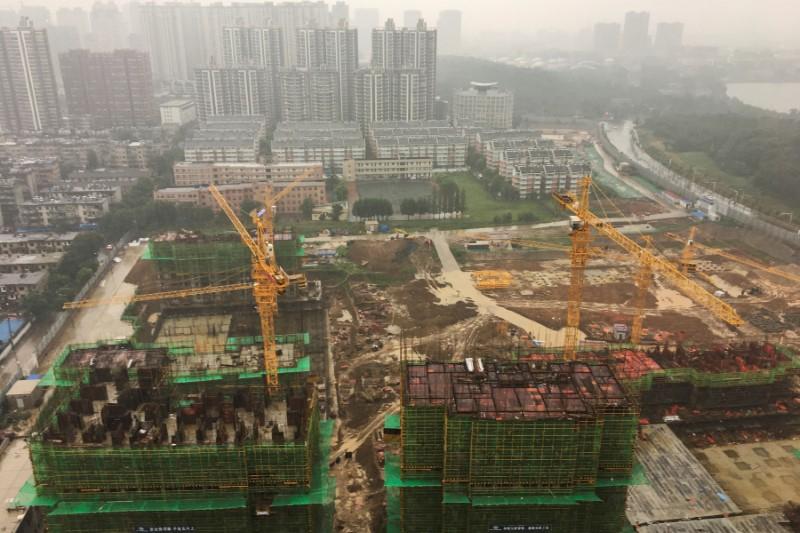
China’s economy continues to defy expectations for a slowdown, buoyed by strong global demand for its exports and a resilient property market – despite a government pledge to crack down on rising risks.
BEIJING (Reuters) – China&rsquo-s economy continues to defy expectations for a slowdown, buoyed by strong global demand for its exports and a resilient property market – despite a government pledge to crack down on rising risks.
Beijing&rsquo-s efforts to consolidate and restructure its industrial sector is paying dividends as profits rise, while strong fiscal spending and sustained infrastructure investment have ensured domestic demand stays strong.
Manufacturing surveys last week showed factories continued to enjoy strong price gains, while demand remained strong with big increases in new business.
All this means there is a good chance China&rsquo-s growth will accelerate for the first time in seven years after growing at a 26-year low of 6.7 percent last year. The economy grew 6.9 percent in the first half of this year.
&ldquo-One factor is government investment- another is the impact from property,&rdquo- said Wang Jun, senior economist at China Centre for International Economic Exchanges (CCIEE), a Beijing-based think-tank.
&ldquo-A resilient property market is a very important factor behind the stronger than expected economic growth, which is still from traditional drivers.&rdquo-
Wang expects China&rsquo-s economy to grow 6.8 percent this year, beating the government&rsquo-s target of around 6.5 percent.
But reliance on old growth drivers – property and exports, a strong state sector, with a large dose of credit greasing the gears – raises concerns about the economy&rsquo-s long-term trajectory.
State firms account for an ever greater portion of overall fixed asset investment, and government-directed infrastructure spending continues to grow at over 20 percent, even as overall fixed asset investment growth has slowed to single digits.
The confidence in the state sector is reflected in the stock market. Investors are betting on state firms to outperform their private company peers. A stock index tracking state-owned firms has outperformed an index of private firms by about 15 percentage points this year.
While government budgetary spending has risen at only a slightly faster pace this year, CCIEE&rsquo-s Wang said fiscal spending data doesn&rsquo-t include off-budget spending, which has expanded via public-private partnerships and local government debt issuance.
Investment in new property development is growing faster this year than last, and sales have held up better than expected this year as demand spills over into smaller cities, said Nie Wen, an economist at Hwabao Trust in Shanghai.
Exports have also rebounded, growing 7 percent in dollar terms through July after two years of declines, even taking into account a surging yuan.
(For a graphic on China’s fixed-asset investment, click tmsnrt.rs/2xdrRpy)
GIVE UP GROWTH TARGET
With growth on track this year, investors are now looking at whether the government will push through tough reforms, especially those targeting state firms, after the October congress of the ruling Communist Party, at which President Xi Jinping is expected to further consolidate power.
State firms dominate upstream industries that have benefited most from commodity price gains, and it is the stronger state firms that come out ahead when weaker competitors are forced to shut down capacity or close operations completely.
&ldquo-We are pushing supply-side reforms, which pushed up prices in upstream sectors, but the spillover to the downstream sectors is not smooth,&rdquo- said Hwabao&rsquo-s Nie.
Indeed, a recent survey of 2,000 Chinese industrial firms by Cheung Kong Graduate School of Business professor Gan Jie found the advantage of state firms over private firms is widening.
There is also the enduring problem of China&rsquo-s massive credit build-up.
Michael Pettis, a finance professor at Peking University, says China has not made significant changes to its growth model, as credit continues to grow faster than nominal GDP. He believes China&rsquo-s natural growth rate is significantly below its current GDP growth rate.
&ldquo-If you want growth more quickly than organic growth, it takes debt. How do you solve the debt problem? Simple, you give up the growth target,&rdquo- Pettis told Reuters.
&ldquo-You can&rsquo-t have the GDP growth target and reduce debt.&rdquo-
(For a graphic on china economy, click tmsnrt.rs/2lQ48De)
 0 comments
0 comments





